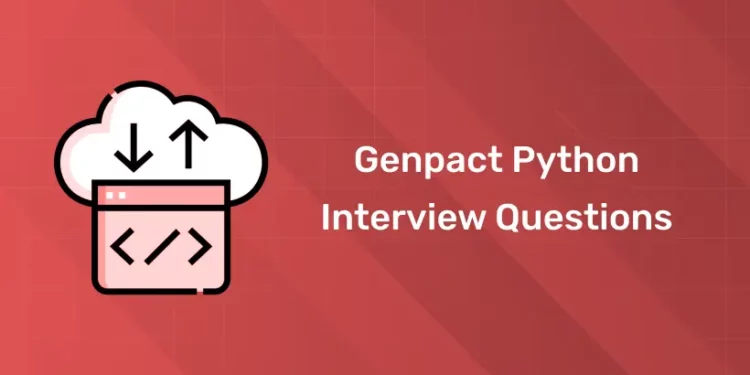Table of Contents
Being a Python developer at Genpact, a global leader in innovation and technology, requires thorough preparation and an understanding of Python’s subtleties. Preparing for a Genpact Python Interview will boost your confidence and chances of success, regardless of your level of experience.
This updated 2024 guide lists the most common and difficult interview questions that Genpact Python Interview may face. This comprehensive guide will offer you with the knowledge and expertise you need to ace your interview, covering everything from fundamental concepts to sophisticated problem-solving techniques.
Experience the power of our python programming course with a free demo – enroll now!
Introduction
Today’s aspiring software engineers would always like to work for organizations that have a strong sense of purpose in the world and believe in the potential of their products. Genpact is among these companies. A global provider of professional services, Genpact assists businesses in changing. “Genpact” is an acronym for “Generating Impact.
With the goal of improving people’s lives worldwide, they lead digitally-led innovation and digitally-enabled intelligent operations for their clients. Driven by their experience in innovating and managing thousands of processes for hundreds of clients—many of whom are Global Fortune 500 businesses—Genpact facilitates real-world transformation at scale. They think with design, dream with digital, and solve problems with data and analytics.
Why Join Genpact
Reviewing your Python fundamentals in-depth and practicing coding tasks are crucial if you’re getting ready for an impending Genpact Python interview. You can ace the interview process like a pro with the correct preparation, even if there are different levels to the procedure, each with their own set of problems. There is a perception among consumers that Genpact can facilitate job advancement while upholding a healthy work-life balance.
1. Innovative Environment
With innovations in artificial intelligence, blockchain, cloud computing, and quantum computing, Genpact is at the forefront of technological innovation and always pushing the boundaries. Also among the many chances that await Python developers is working on cutting-edge projects that shape the course of technology.
2. Global Impact
In this sense, Genpact provides services and solutions to a wide range of industries and has operations in more than 170 countries. Here working with Genpact means being a part of a global team that addresses urgent problems and offers meaningful solutions all across the world. And your efforts will be widely viewed and influential.
3. Career Development
Career development would be like, Genpact is committed to the continuous professional development of its employees. And the organisation offers a variety of training programmes, certifications, and tools to help you advance your skills and career. Alos whether you wish to focus in a certain area or explore new technologies, Genpact supports you throughout your career.
4. Collaborative Culture
The firm Genpact encourages collaboration and a friendly work atmosphere that fosters innovation, creativity, and teamwork. Also you’ll get the ability to collaborate on projects that genuinely effect change and share ideas with some of the most intelligent people in the industry.
5. Commitment to Diversity
This will ensure that, Genpact is dedicated to building a diverse and inclusive workforce. The company values different perspectives and experiences in order to create an atmosphere where everyone may thrive and contribute. And Genpact demonstrates its commitment to diversity and inclusion through its policies, activities, and projects.
6. Brand name
7. Work environment
8. Colleagues
Genpact Python Interview Preparation Tips
1.Understand the Job Role:
Examine the job description in its entirety for the Genpact Data Analyst position prior to the interview. Recognize the main duties and necessary competencies. This will assist you in matching your prior experiences and abilities to the job specifications.
2.Research the Company:
Learn about the vision, core principles, corporate culture, and most recent news of Genpact. You may better personalize your responses to highlight how you can support the objectives of the firm by being aware of its services, business model, and clientele.
3.Brush Up on Technical Skills:
In order to learn more about your capacity for problem-solving, collaboration, and handling pressure, Genpact may pose behavioral inquiries. To organize your responses, use the STAR approach (Situation, Task, Action, Result).
4.Prepare for Behavioral Questions:
In order to learn more about your capacity for problem-solving, collaboration, and handling pressure, Genpact may pose behavioral inquiries. To organize your responses, use the STAR approach (Situation, Task, Action, Result).
5.Showcase Your Analytical Skills:
Prepare a brief explanation of your background in statistical analysis, data modeling, and data analysis. Give instances of how you’ve applied these abilities to influence company choices.
6.Review Your Past Projects:
Be ready to go into great detail about the tasks you have completed, the difficulties you have encountered, and the solutions you have found. This will show off your capacity to solve problems and collaborate with others.
7. Prepare the interviewer’s questions:
You can assess whether Genpact is the appropriate fit for you by posing meaningful questions to the team, organization, and role. This will demonstrate your interest in the role.
8.Practice Data-Related Questions:
It’s possible that you’ll be asked to interpret data sets or describe how you would respond in certain situations involving data. Try answering these kinds of questions to show off your ability to think critically and solve problems.
9. Emphasize Your Ability to Communicate:
You will need to clearly and succinctly present complicated data results in your role as a data analyst. During the interview, be ready to demonstrate your communication abilities.
10. Be Enthusiastic:
Demonstrate your enthusiasm for data analysis and your excitement about the prospect of working for Genpact. This can help you stand out from the competition.
Top Genpact Python Interview Questions and Answers
Q. What is a dynamically typed language?
- Static: Before execution, data types are verified.
- Dynamic: During execution, data types are verified.
Q. What is PIP?
Answer: The Python Installer Package, or PIP for short, offers a smooth interface for installing different Python modules. It’s a command-line utility that can look up packages online and install them without requiring user input.
Q. What is a zip function?
Answer: The Python zip() function yields a zip object that maps many containers’ comparable indexes. It starts with an iterable, turns it into an iterator, and then aggregates the elements according to the passed iterables. An iterator of tuples is returned.
Q. Does Python supports multiple Inheritance?
Answer: Unlike Java, Python allows for multiple inheritance. A class may inherit from more than one parent class thanks to multiple inheritances.
Q. What is Polymorphism in Python?
Answer: Being polymorphic refers to having numerous forms. It is therefore possible for the child class to have a method with the same name, ABC, but with different parameters and variables if the parent class has a method with the same name. Python is polymorphism-friendly.
Q. What is PEP 8 and explain its significance?
Q. What does Python scope mean?
- The local objects accessible in the current function are referred to as the local scope.
- The items that have been accessible since the beginning of code execution are referred to as the global scope.
- The global objects of the current module that are accessible within the programme are referred to as a module-level scope.
- The term “outermost scope” describes all of the program’s callable built-in names. The name mentioned is found by searching the items in this scope last.
Q. What are lists and tuples? What are the key difference between them?
def myEmptyFunc():
# do nothing
pass
myEmptyFunc() # nothing happend
## Without the pass keyword
# File "<stdin>", line 3
# IndentationError: expected an indented blockQ. What are modules and packages in Python?
- Modules: Generally speaking, modules are just Python files with a.py extension that include a set of declared and implemented variables, classes, or functions. The import statement can be used to import them and initialise them once. Use the foo import bar to import the necessary classes or functions if only a portion of the functionality is required.
- Packages: Packages enable the module namespace to be organised hierarchically using dot notation. Similar to how modules prevent name conflicts between global variables, packages also aid in preventing name conflicts between modules.
Q. What are global, protected and private attributes in Python?
- Public variables defined within the global scope are referred to as global variables. We utilise the global keyword inside a function to access the variable in the global scope.
- Protected attributes are those that have an underscore (_sara, for example) prefixed to their identification. Although they are still accessible and modifiable from outside the class in which they are declared, a prudent developer should not do so.
- Private attributes are those that have a double underscore (__ansh) prefixed to their identifier. They cannot be directly accessed or modified from the outside, and any effort to do so would raise an AttributeError.
Q. What is the use of self in Python?
Q. What are unit tests in Python?
Answer:
- Python’s unit testing framework is called unit test.
- Unit testing is the process of testing individual software components.
- For this reason, it’s essential to thoroughly test every component to identify the one that may be mostly to blame for the software’s failure.
Q. What is docstring in Python?
Answer:
- A multiline string known as a documentation string, or docstring, is used to describe a particular code segment.
- The function or method’s purpose should be explained in the docstring.
Q. What is slicing in Python?
Answer:
- As the term implies, “slicing” refers to removing portions.
- Slicing has the syntax [start : stop : step].
- start is the index to begin slicing a list or tuple from.
- The finishing index, or where to sop, is stop.
- The number of steps to jump is called step.
- Start is set to 0, step is set to the number of items, and stop is set to 1.
- Lists, tuples, arrays, and strings can all be chopped.
Q. What is Scope Resolution in Python?
Answer: Objects in the same scope may have various functions under different names. In these situations, Python’s scope resolution mechanism kicks in immediately. Some instances of this kind of behaviour are:
- There are numerous functions shared by the two Python modules “math” and “cmath,” such as log10(), acos(), and exp(). It is need to prefix them with the appropriate module, such as math.exp() and cmath.exp(), in order to clear up this issue.
Q. What are the difference between .py and .pyc files?
Answer:
- The program’s source code is contained in.py files. The bytecode of your programme is contained in the.pyc file, however. After the.py file (source code) is compiled, we obtain bytecode. Not every file you execute results in a.pyc file being created. It is made exclusively for the files you import.
- A Python program’s interpreter looks for the built files before running it. The virtual computer runs the file if it exists. It looks for a.py file if it cannot be found. If it is located, it is compiled into a.pyc file and run on a Python virtual machine.
- Compilation time is reduced when you have a.pyc file.
Experience the power of our python programming course with a free demo – enroll now!
Q. To find the sum of a list of numbers, write a Python programme.
Answer:
def sum(num):
if len(num) == 1: return num[0] # The total result will equal the element if the list has just one element.
else: return num[0] + sum(num[1:]) print(sum([2, 3,4, 5, 6, 7]))Q. Write a palindrome checker using Python. Making use of an empty array for item assignment?
Answer:
string='Mome'res=[]defchecker(a): res=a[::-1]ifres==a:else:Word nota palindrome
Q. Write a Python programme that, without utilising the len() function, prints the length of an array.
X=[1,2,3,4,5] count=0foriinX: count=count+1
Output:
5
Q. Write a Python program to find the largest of two numbers?
Answer:
a=4b=8("x is greater")ifa > belse('Both are equal')ifa==belse('b is greater') Output: bisgreater a=12 b=4"a is greater")ifa > belse'Both are equal')ifa==belseis greater') Output: aisgreater a=12 b=12"a is greater")ifa > belse'Both are equal')ifa==belse'b is greater')
Output:
Both a and b are equal
Q. To determine whether the input is an Armstrong number or not, write a Python programme.
Answer:
defarmstrong(num):sum=0temp=numwhiletemp >0: x=temp%10sum=sum+a**3 temp=temp//10"armstrong")ifsum==numelse"not armstrong") armstrong( 407)
Output:
The number is Armstrong
Q. Write a Python program to depict list comprehension?
Answer:
Here’s a basic example of using list comprehension to generate a list.
[a**2 for a in range(0,100,10)]
Output:
[0, 100, 400, 900, 1600, 2500, 3600, 4900, 6400, 8100]Q. Write a Python program that will depict dictionary comprehension in Python?
Answer:
Here’s a basic example of using list comprehension to generate a list.
{a: a**2 for a in range(0,100,10)}
{0: 0,
10: 100,
20: 400,
30: 900,
40: 1600,
50: 2500,
60: 3600,
70: 4900,
80: 6400,
90: 8100}
Q. Write a Python program to demonstrate abstraction in Python?
Answer:
fromxyzimportXYZ, abstractmethodclassX(XYZ):@abstractmethoddefsum(self):pass class Y(X): defsum(self, x, y):self.x = xself.y = yreturnself.x//self.y obj=Y() obj.sum(20,2)
Output:
10.
Q. Explain about generators in Python?
Answer: Python generators are unique functions that let you make iterable objects. Generators employ the yield keyword to halt execution momentarily and yield values one at a time, in contrast to normal functions that return a value and then exit. Because they only produce values as needed rather than the full series of values at once, this makes generators memory efficient.
When working with enormous datasets or when the entire value sequence is not required at once, generators come in handy. They spare us from using up too much memory by enabling us to loop over an essentially limitless sequence.
Q. Explain the difference between pickling and unpickling?
Answer: The Python object is accepted by the Pickle module, which uses the dump method to transform it into a string representation and save it to a file. We call this process pickling. Conversely, unpickling is the act of obtaining the original Python objects from the textual representation.
Q. Describe the split(), sub(), and subn() methods found within Python’s ‘re’ module?
Answer: These functions are used to alter strings and are part of the Python RegEx, or “re,” package.
- split(): This function divides a supplied string into a list.
- sub(): This function replaces the matched substring with an alternate string after determining which substring a regex pattern matches.
- subn(): This function returns the new string plus the number of replacements; otherwise, it functions similarly to sub().
Q. What is a map function in Python?
Answer: Method and iterable are the two parameters used by Python’s map() method. One useful tool that lets you apply a function to each element in an iterable is the map() function. It requires two arguments: an iterable containing the elements you wish to process and the function you wish to apply. With the help of this function, you can work on several objects at once in a flexible manner, which will improve the efficiency and clarity of your code.
Experience the power of our python programming course with a free demo – enroll now!
🚀 Start Coding Today! Enroll Now with Easy EMI Options. 💳✨
Gain expertise in Django and open doors to lucrative opportunities in web development.
Start Learning With EMI Payment OptionsFrequently Asked Questions
Is it hard to crack Genpact interview?
Does Genpact have coding rounds?
Is working at Genpact stressful?
Is it worthwhile to join Genpact?
One of the best companies is Genpact, where there is no distinction between senior and fresh employees and you can operate in an incredibly peaceful setting with all of your supervisors. to sum up in one phrase: a delightful company from all angles. Genpact has an excellent work culture. Company policies are also excellent.













